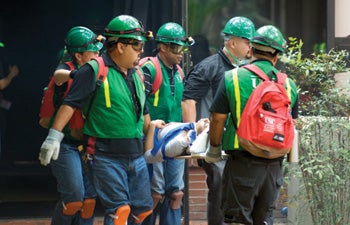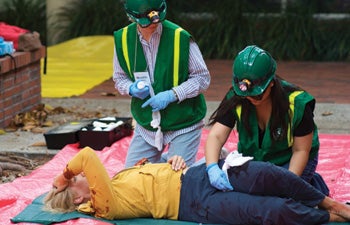Los Angeles’ 8.8 Wake-Up Call
“We live in earthquake country and every day is earthquake season.”
This is Tom Jordan’s mantra.
The director of the Southern California Earthquake Center (SCEC) based in USC College notes that while residents elsewhere in the country brace for hurricane and tornado seasons, Californians must always be on guard for the state’s most common natural disaster.
Thousands of earthquakes occur in Southern California each year, though most pass unnoticed except to seismologists and other scientists such as Jordan, University Professor and W.M. Keck Foundation Chair in Geological Sciences.
The nation’s premier academic earthquake research organization, SCEC unites seismologists and scientists from across the world. More than 600 scientists from 63 international institutions collaborate to gather data, develop forecasting models, and educate the public on earthquake awareness and preparedness.

The largest earthquake preparedness drill in U.S. history is the Great Southern California ShakeOut, developed and headquartered at the Southern California Earthquake Center, based in USC College. In this image, emergency workers tend to a volunteer made to look like an injured earthquake victim during a drill on University Park campus. Photo credit Dietmar Quistorf.
In the wake of the 7.0-magnitude earthquake in Haiti and the 8.8-magnitude earthquake in Chile, the world has turned to SCEC for answers.
“Earthquakes are one of those things that people don’t realize are a big threat until something like Haiti happens,” Jordan said. “Otherwise, it’s in the back of their minds.”
To Jordan and his team, the threat of temblors is ever present. And while the exact timing of the Haiti and Chile earthquakes could not have been predicted, the large magnitude and location of both quakes did not come as a complete surprise.
Haiti has two active fault lines running through the country and Chile sits on an area known as the “ring of fire,” a system of active faults that circles the Pacific Ocean and frequently experiences tremors.
Southern California has its own notorious fault line: the San Andreas.
Evidence suggests that on the southern San Andreas Fault, an earthquake 7.7 magnitude or larger occurs every 100 to 140 years. The last, a 7.9-magnitude quake, occurred in 1857.
The question now is not if a large earthquake will hit Southern California in our lifetimes, but when.
“The whole southern section of the San Andreas Fault is locked and loaded,” Jordan said. “‘It’s ready to go.’”
One might think that the recent deadly quakes would encourage more vigilance on the part of Angelenos, especially considering the disasters’ direct effect on the United States. The Chilean earthquake resulted in warnings of a tsunami in Hawaii and receding water lines in Long Beach and Malibu. But in the end, the waves in Hawaii reached only 3 feet, and the Southern California coast was unaffected.
That the U.S. escaped unscathed, combined with California’s recent period of earthquake quiescence, have caused some to doubt the necessity of preparing for a local quake. College student Aron Theising, a freshman majoring in economics, for example, admits that he has not prepared.
“As far as the potential of having what happened in Chile with the 8.8 earthquake happen here, I don’t think it’s that significant of a concern,” Theising said. “I’m not too worried about earthquakes because I’ve been in one and it’s not too terrifying.”
Theising’s sentiment is not unusual. According to data from the 2008 Great Southern California ShakeOut, the largest earthquake drill in U.S. history, few are ready. Organized by SCEC and its partners, the ShakeOut is an annual event now used as a model for drills throughout the world.
The USC Annenberg School for Communication’s Norman Lear Center conducted a survey involving more than 3,000 ShakeOut participants. Of those surveyed, 12 percent described themselves as “very well-prepared” for a large-scale earthquake, 56 percent were “somewhat prepared,” 26 percent were “fairly unprepared,” and 6 percent were “totally unprepared.”
So why all the apathy? Jordan believes it’s because people haven’t experienced an earthquake on the scale of the predicted Big One. Earthquakes Angelenos have felt, such as the 5.4-magnitude Chino Hills quake in 2008, are not in the same realm as the one that may occur in the next 30 years.
“After an earthquake like Chino Hills, everyone gets excited and wants to prepare for earthquakes because they felt one,” Jordan said. “Then they say that they’ve lived through an earthquake, and it wasn’t so bad. But these are seismologically insignificant events.”
Even the 6.7-magnitude Northridge earthquake in 1994 is not comparable. Although 57 people were killed and the quake was reportedly the costliest national disaster to hit the U.S. until Hurricane Katrina, Jordan maintains, “In the budget of earthquakes, it was a drop in the bucket.”
“Northridge had a 15-mile long fault. In the San Andreas, it might be 200 miles or more that break in one earthquake.”
Despite an apparent laissez-faire attitude, more than 6.9 million participated in the 2009 Great California ShakeOut, and more than 1.6 million have already signed up for the 2010 drill, scheduled for Oct. 21 at 10:21 a.m. Eight central states are also considering a drill set for April 2011, in preparation for the bicentennial of the 1812 New Madrid earthquakes.

During the Great Southern California ShakeOut earthquake drill, emergency workers tend to a volunteer made to look like an injured earthquake victim. Photo credit Dietmar Quistorf.
The drill has been so successful it has expanded overseas. New Zealand practiced its own ShakeOut in 2009, and British Columbia will participate in 2010.
The ShakeOut is led by Mark Benthien, executive director of the Earthquake Country Alliance (ECA), an organization created by SCEC in 2003 to share existing earthquake resources throughout California.
Most people don’t know what actions to take during an earthquake, Benthien said. The purpose of the ShakeOut is to help Californians prepare.
“People need to practice ‘drop, cover and hold on’ at home, work and school,” said Benthien, SCEC’s director for communication, education and outreach. “Having actually done it in practice makes a big difference.”
SCEC’s mission not only involves educating and preparing the community. It is also developing an earthquake “prediction” model.
As of yet there is no silver bullet solution that can precisely indicate an impending earthquake. And Jordan believes there may never be. Instead, he advocates a “brick-by-brick” approach, building a system like the one used in weather forecasting.
“You don’t forecast the weather because you see some special cloud,” Jordan said. “You forecast it because you understand how the atmosphere works, and you build a model.”
But earthquakes are incredibly difficult to understand. Just ask Danijel Schorlemmer, assistant professor of research in earth sciences and SCEC seismologist. Schorlemmer has developed a forecasting model that aims to predict the approximate size and location of earthquakes, but the data-gathering process is tricky because it relies on observing earthquakes in progress.
“Weather is easier to observe,” Schorlemmer said. “You can measure storms by measuring the previous weather conditions. But with earthquakes, we can only measure the earthquake itself.”
Earthquake prediction is a fundamental question of seismology, but before an early warning system can be developed, seismologists must fully understand the earthquake itself. That is one of SCEC’s main focuses.
“We’re beginning to understand how earthquake probabilities change with time,” Jordan said. “These changes can be substantial in the short term — factors of 100 or more relative to the chances on an ordinary day. With our current understanding, the daily forecasting probabilities never get much higher than a percent or so. We can’t predict earthquakes with high short-term probabilities.
“Still, the forecasting information can be useful. Think about how you react to red flag warnings during fire seasons. Although the chance of your home burning down is pretty small, you still take precautions. The same should be true for earthquakes.”
So when the Big One hits, will you be ready?
For more information on the Great Southern California ShakeOut, visit www.shakeout.org
7 steps to earthquake safety
Developed by the Earthquake Country Alliance, here are recommendations for what to do before, during and after an earthquake. Visit earthquakecountry.info for more information.
PREPARE
1. Secure it now! Reduce and/or eliminate hazards. Secure televisions, computers, bookcases, furniture, picture frames, etc. so they won’t fall on you during an earthquake.
2. Make a plan. Create an emergency plan that includes evacuation routes and reunion locations, out-of-state contacts, and where your emergency supplies are stored.
3. Make disaster kits. Every person in your home should have a kit stored in an accessible location at home, work/school and in their vehicle. Include snack food, water, flashlights, portable radios, batteries, a first aid kit, cash, extra medications, a whistle, and a fire extinguisher. Store at least three gallons of water per person in your home. Water lines could be destroyed during a large-scale earthquake.
4. Is your place safe? Most houses are not as safe as they could be. Consider improving the structural integrity of your home. Look for inadequately braced first stories, unreinforced masonry and vulnerable pipes. Fix them now.
PROTECT
5. DROP, COVER, and HOLD ON! During an earthquake, drop to the floor, take cover under a sturdy desk or table, and hold on to it firmly. Be prepared to move with it until the shaking stops.
RECOVER
6. Check it out. Check for injuries and damages that need immediate attention. Know basic first aid and identify hazards such as damaged gas, water, sewage and electrical lines.
7. Communicate and recover. Turn on your portable radio for information and safety advisories. Remember your emergency plans. Aftershocks may cause additional damage or items to fall, so get to a safe location. Bring your disaster supplies kit.
Read more articles from USC College Magazine’s Spring/Summer 2010 issue.